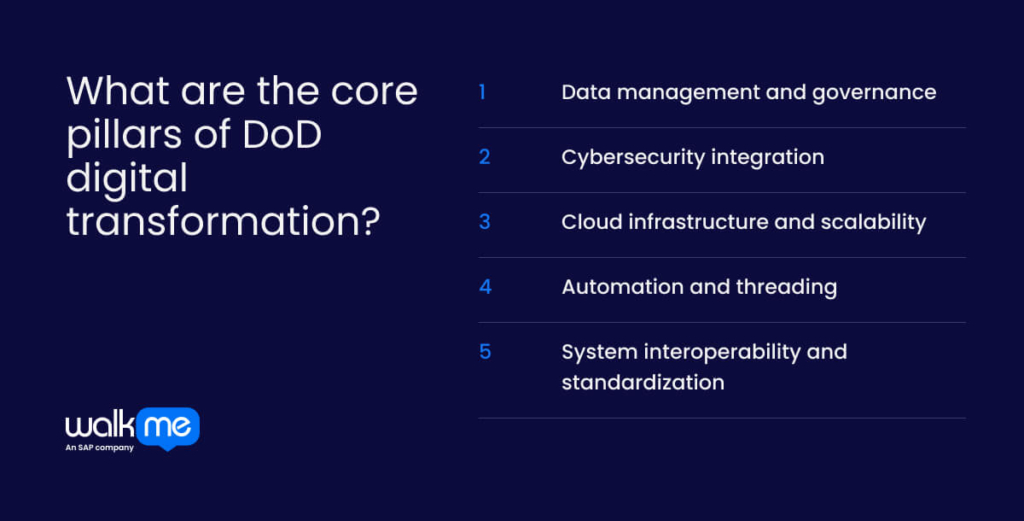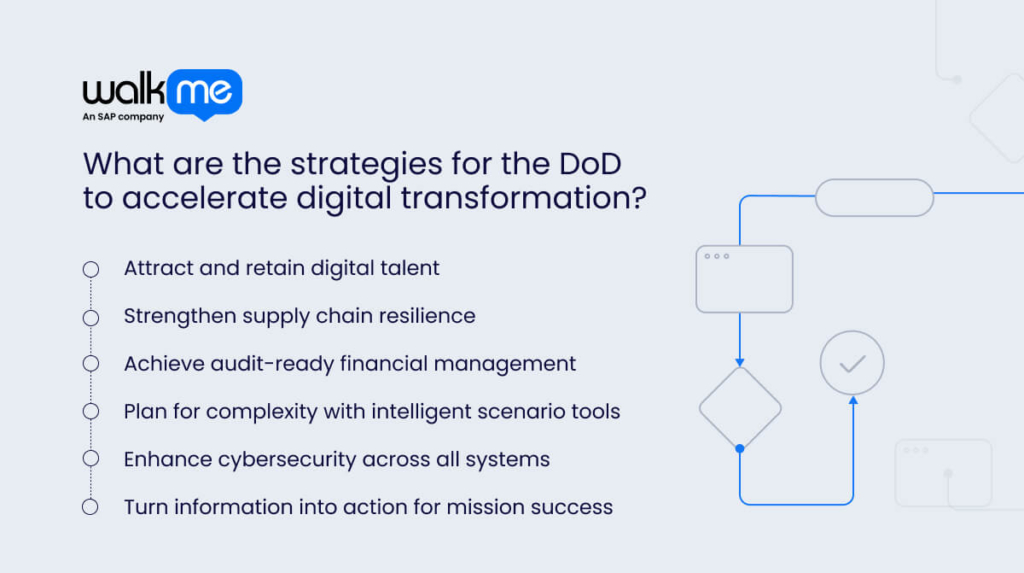The U.S. Department of Defense (DoD) is ushering in an era where technology adoption is as critical to national security as military strategy.
With global cybersecurity threats becoming increasingly complex, the DoD’s digital transformation is now looked at with a renewed sense of urgency.
In recent years, publications like the National Defense Strategy and reports from the Defense Innovation Board highlight the need for adaptive, technology-driven forces.
Everything from integrating AI to modernizing legacy systems is being overhauled, with the DoD poised to reshape defense capabilities in the coming years.
As defense and technology sectors converge, the DoD’s organizational alignment can be seen as a necessary survival strategy in a world where technology disrupts every industry, especially those as critical as defense.
This article explores how the Department of Defense approaches digital transformation through modern technologies, strategic partnerships, and operational reform.
What is DoD digital transformation?
The Department of Defense (DoD) is facing a new reality, given the significant technological innovation it has experienced over the last decade.
The ability to manage and deploy cutting-edge technology is now as important as military stability. With global tensions rising and digital threats growing more sophisticated, the DoD is overhauling its infrastructure to remain ahead.
Every aspect of its DoD digital transformation is designed to adapt and respond to new challenges. This includes modernizing outdated legacy systems and implementing artificial intelligence.
As defense strategies evolve, the push for system integration will secure the future of the nation’s defense capabilities in a tech-centric world.
Why is DoD digital transformation important?
For the Department of Defense (DoD), digital transformation should examine holistically all operations that can evolve given the right technological push.
Cyber threats are growing more sophisticated every day, and with the attack surface expanding, real-time access to data and agile software development is vital.
The DoD’s focus on cloud infrastructure, like the Joint All-Domain Command and Control (JADC2) system, allows forces to cooperate, sharing intelligence across multiple domains.
Technological upgrades like these mean the DoD remains ahead in a fast-changing environment, securing national interests against emerging threats.
One more thing to consider is the cultural shift required to support these changes. Without buy-in from DoD leadership, even the systems with the heaviest investments risk falling short of their promise.
What is the DoD Fulcrum IT advancement strategy?
Fulcrum is the DoD’s blueprint for IT modernization, designed as a full-scale recalibration of how digital systems support military operations.
Ultimately, Fulcrum is about relevance and ensuring digital infrastructure doesn’t lag behind mission needs. Its priorities reflect a move toward solutions that respond directly to operational demands. These systems load quickly, scale effortlessly, and are built with end users in mind.
For example, Fulcrum’s emphasis on resilient platforms echoes initiatives like the Defense Enclave Services program, consolidating IT infrastructure across defense agencies to reduce fragmentation and improve operational clarity.
The strategy’s call for secure-by-design principles underscores a broader cybersecurity push, protecting assets from evolving digital threats. And by cultivating a digital-first workforce, Fulcrum acknowledges that modernization is as much about people as it is about platforms.
These lines of effort, including joint IT capabilities, network modernization, streamlined governance, and tech-ready personnel, don’t operate in isolation. They support the National Defense Strategy’s call for agile, responsive forces to outpace adversaries in code, cloud, and every digital touchpoint.
What are the core pillars of DoD digital transformation?

Now that you understand what digital transformation in the DoD is, why it matters, and how it connects to the broader Fulcrum IT advancement strategy, it’s time to examine the core pillars driving this shift.
Understanding these pillars will help clarify where change is happening, how it’s being prioritized, and what it means in practice.
Let’s take a closer look at the core pillars of DoD digital transformation:
Data management and governance
Good data management helps the DoD make instantaneous decisions. One example is ADVANA, a system that brings together data from across the military in one place. It allows leaders to spot patterns and avoid repetition. Organizing data clearly and keeping it safe lets teams act quickly, whether planning missions, managing supplies, or tracking operations.
Cybersecurity integration
Cyber threats don’t wait, and the DoD treats security as part of everything it builds. With Zero Trust, systems don’t automatically trust anyone, even inside the network. A project called Thunderdome shows how this works and checks who’s using what, at every moment. If someone breaks in, they can’t move around freely. This makes it harder for hackers to do real damage, even if they get past the front door.
Cloud infrastructure and scalability
The DoD uses the cloud to help internal developers build and scale applications quicker than ever before. The Air Force’s Cloud One platform lets teams create apps and share them anywhere, even with troops overseas. This means that software can go live in days instead of months. When time matters, this cloud setup helps commanders and soldiers work with the latest tools, no matter where they are in the world.
Automation and threading
Automation in the military has always been about cutting down work-related activity so people can focus on what matters. The USS Fitzgerald is the first Navy ship to use ERM v4, an AI-powered system that predicts maintenance problems before they happen. It tracks 10,000 sensor readings every second to spot issues early, helping crews fix problems without waiting for something to break. This system replaces older tools from the ’90s and keeps more ships ready to deploy.
System interoperability and standardization
When military equipment works in tandem, things move faster and more safely. The Army’s IVAS headset is a good example. It connects maps, GPS, night vision, and more into one view for soldiers. Instead of switching tools or getting updates from different devices, everything shows up in real time. Because different systems speak the same “language,” troops don’t lose time or focus, which can make a huge difference.
What are the strategies for the DoD to accelerate digital transformation?

Understanding the core pillars should have taught you how the Department of Defense is rebuilding its digital backbone, where strategy, technology, and readiness all intersect.
Now it’s time to learn about the tangible strategies the DoD uses to accelerate digital transformation. Let’s take a closer look:
Attract and retain digital talent
“Attract and retain digital talent” always comes up in transformation strategies because people drive real change. For the DoD, this matters even more. Modern defense systems demand engineers, coders, and analysts who understand both tech and mission needs. Without skilled talent, no amount of infrastructure or tools can deliver.
Strengthen supply chain resilience
The DoD reinforces its supply chains using digital twin technology to simulate disruptions and reroute logistics in real time. During the COVID-19 pandemic, these tools helped maintain overseas equipment delivery. Such systems now map supplier dependencies, flagging risks early, especially for microelectronics vital to air defense and missile systems.
Achieve audit-ready financial management
The Army uses Advana, a DoD-wide analytics platform, to centralize spending records and automate compliance checks. It flagged $250 million in invoice errors in 2023 alone. With AI-assisted bookkeeping, finance teams can trace every dollar, cutting the risk of budget misreporting and streamlining the path toward clean audit outcomes.
Plan for complexity with intelligent scenario tools
To prepare for future conflicts, the Air Force employs AI-powered wargaming software that runs thousands of battle scenarios based on current global data. These simulations inform budgeting, logistics, and deployment models, allowing commanders to rehearse high-stakes decisions without real-world fallout.
Enhance cybersecurity across all systems
The DoD’s zero-trust architecture pilot, led by DISA, is active across 12 defense networks. It segments access down to individual user roles and device health. In 2024, it blocked over 15 million unauthorized login attempts, proving that real-time validation across systems is a matter of mission continuity.
Turn information into action for mission success
DARPA’s Perceptually-enabled Task Guidance project gives soldiers heads-up visual prompts in live combat, pulling from real-time mission data. Instead of reading through manuals or waiting for instructions, troops get contextual guidance through AR.
What are the benefits of DoD digital transformation?
Understanding how the DoD applies digital transformation in real-world operations reveals far more than a tool shift. It shows how strategy, readiness, and coordination are all being redefined.
Let’s take a closer look at the benefits of digital transformation in the DoD:
Improved real-time decision-making
Digital military tools let service leaders access live data from all over the battlefield, helping them make quick decisions. For example, satellites send instant updates that help commanders respond faster to changing situations, like enemy movements, improving the chances of mission success.
Better battlefield data synchronization
The DoD connects data from different sources, such as drones and soldiers, to create a clear picture of the situation. This allows military teams to work together better and share important information right away. For instance, intelligence gathered by drones is instantly available to all units on the ground.
Stronger cybersecurity with cloud tech
The DoD uses multi-cloud technology to protect sensitive data. Cloud systems keep military information safe by storing it in encrypted servers, making it harder for hackers to break in. For example, communication between planes and troops is now more secure, thanks to cloud tech that strengthens cybersecurity across the military’s networks.
What challenges is the DoD facing in its digital transformation?
While the DoD’s digital transformation offers immense potential, it also presents a unique set of obstacles that require careful attention.
Technological change is always accelerating; thus, overcoming it will be essential for maintaining effectiveness and security in an increasingly complex defense environment.
With that in mind, let’s take a closer look at the challenges the DoD faces when implementing digital transformation:
Obsolete, insecure systems
Many of the DoD’s old systems were built years ago and aren’t secure enough for today’s threats. These outdated systems are expensive and slow to update, making it harder to stay safe from cyberattacks and slowing down digital progress.
Budget constraints on modernization
The DoD’s limited budget makes it tough to fund big digital upgrades. Because of this, they often have to focus on urgent needs rather than long-term technology improvements, meaning they can’t always invest in the latest stack or complete critical updates.
Integrating AI into existing frameworks
Adding AI into the DoD’s current systems is tricky. AI adoption must be compatible with older tech while ensuring it’s safe, ethical, and works as required. Training civil servants and departmental staff to use AI properly makes this process even more complicated.
What’s next for DoD digital transformation?
What’s next for DoD digital transformation is an exciting and illuminating journey.
Technology advancements will modify how crucial missions are prepared, executed, and learned from.
The focus is shifting toward systems that adapt in real time, software that can self-correct during operations, and training environments powered by high-fidelity simulations.
Future defense planning may rely more on virtual testbeds that let commanders model the impact of decisions before making them. As technologies like quantum computing and 5G mature, the DoD will need to build flexible architectures that support constant change without breaking older systems.
Long-term DoD transformation will depend on how fast people and processes evolve, including both AI and human intelligence.
FAQs
The DoD ranks digital projects by mission impact, urgency, and readiness. Programs that improve joint force coordination, reduce risk, or close capability gaps move first. Strategic roadmaps, like Fulcrum, help allocate funding and talent where they’ll make the biggest difference across warfighting, logistics, and cybersecurity domains.
Unmanned systems are testbeds for advanced tech integration. Drones and autonomous vehicles gather real-time data, extend surveillance, and reduce human exposure in combat zones. The DoD uses these systems to trial AI navigation, edge computing, and secure comms. This accelerates transformation without overhauling crewed platforms immediately.
Rather than replacing everything simultaneously, the DoD is phasing out outdated tech through modular upgrades. It prioritizes systems that block interoperability or create security risks. Programs like data fabric integration allow newer platforms to coexist with legacy infrastructure while improving overall capability.

